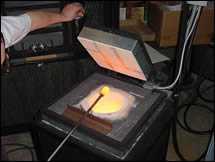Description
The finished furnace with the counterweight and foot pedal. The door bricks and fiber panels are all painted flat black. This provides a few functions. Firstly, a crust which prevents airborne fibers, secondly, a bit of mechanical protection against erosion of the fiber exposed by the expanded mesh. Thirdly, the color and texture of the paint aids in the ability of accumulated heat to radiate from the insulation’s outer surface. When I place my hand on the furnace sides, the temperature is just slightly warmer than room temp. Compare this to furnaces with shiny sheet metal skins that you can’t even touch! Next is a photo of the hearth brick. It is a hard firebrick “split” and is positioned right in front of the curved trough brick casting, and directly under the door bricks. Ladle gathers often result in a thin thread of glass following the gather out of the furnace. (There is no flame in electric furnaces to burn off this thread.) The tight closure of the door can be affected by an accumulation of hardened stringers in this location. If the door is open even a wee bit, convection cooling can happen where cold air can rush in to fill a void created by the escaping hot air. These “consumable” bricks are just over $1.00 each and can easily be swapped while the furnace is hot, as required. There is 1/2″ of sand sitting on the fiber insulation beneath the region where the cast curved trough brick meets the front brick, in case there is any glass seeping down between them. A small bed of sand is really useful for the removal of any gummy parts like this, and can also easily be replenished while the furnace is hot.
The total cost to build this in 2003 was $4000. Below is a picture of the furnace at operating temperature. Note the build-up of hardened stringers below the yoke bar.




Recent Comments